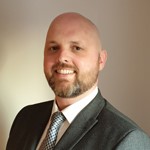My first year on the GOsC Council
17 May 2021
Daniel Bailey reflects on how the COVID-19 pandemic took hold during his first year on GOsC’s Council
I was fortunate enough to be appointed in March 2020 and became a member of one of the UK’s nine healthcare regulators, just as the most severe pandemic ever to affect the world took hold.
Given the unusual timing, I had to hit the ground running. My first task was to take part in an emergency video conference of Council to discuss the response to the emerging crisis. Like many of my colleagues, at that point I was trying to deal with the impact of COVID-19 on my own clinical practice, modifying my teaching role so it could take place online, and simultaneously home-schooling my own children. This was a steep learning curve for me. But equally it was reassuring and felt empowering to be playing a crucial role in the profession’s response to the COVID-19 crisis, as part of the GOsC and in partnership with the other key organisations across osteopathy.
it was reassuring and felt empowering to be playing a crucial role in the profession’s response to the COVID-19 crisis
What quickly became apparent to me, was the difficulty and frustration in finding publicly available information that was applicable to all members of the profession. Many osteopaths looked to the GOsC for explicit guidance on how to respond to the pandemic, but the complexities of the situation precluded such definitive advice.
For me, the pandemic brought into stark focus the diversity of osteopathic practice in the UK. While some osteopaths work from larger clinical facilities and may have felt confident in continuing to practise, others working from home may have felt that the risk of bringing patients close to their family was unacceptable. Conversely, those working from places such as gyms were denied any such choice, as government restrictions had taken the decision out of their hands.
A complicating factor that I had not previously considered was the devolved nations. We are now all familiar with the variations in how the different countries in the UK have managed their response to COVID-19, however, the fact that the devolved nations regulate their healthcare autonomously impacts greatly on how the GOsC governs the profession. I must admit I had previously been very England-centric in my thinking, and not considered issues such as how our recently acquired allied healthcare professional (AHP) status does not extend to all four nations. This has meant opportunities for osteopaths to become involved with the NHS to help fight the pandemic have varied across the UK. It is these variations, not only between the circumstances of individual osteopaths but also the countries in which they practise, that has made responding to the pandemic uniquely challenging.
The pandemic has clearly absorbed a large amount of GOsC time over the past year, but I’m pleased that the usual responsibilities of regulation have continued, and like many organisations we have begun to work in new ways. The swift shift to the use of video conferencing for Council meetings has allowed the executive team to continue their work without significant delay. Its integration into fitness to practise hearings has also prevented what can be stressful experiences for patients and clinicians, becoming any more protracted than necessary. A bonus to increasing the use of this mode of communication is that of reduced costs, which have helped the GOsC to keep registration fees at the same level for another year.
And finally I want to make particular mention of the patient engagement work the GOsC conducted at the beginning and part way through the pandemic, which you can read about in the article on page 8 of the winter 2020 issue of The Osteopath magazine. This highlights the loss of the patient voice in healthcare decision-making during the crisis and explores osteopathic patients’ perceptions of seeking care during this time. The insights gleaned from this, particularly how patients’ views changed over time, will be helpful for osteopaths working with patients who may be re-engaging with osteopathy in post-COVID clinical practice and I would encourage everyone to read it.




